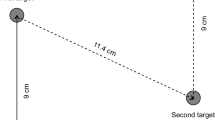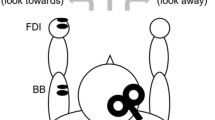Abstract
There is controversy within the literature regarding the influence of task instruction on the size of the long-latency stretch reflex (M2) elicited by a joint displacement. The aim of this study was to investigate if the previously reported task-dependent modulation of the M2 is specific to the M2 or can be explained by an early release of the intended voluntary response. We took advantage of the fact that the M2 is absent when the duration of the applied perturbation is less than a critical time period. This allowed us to examine modulation of muscle activity with and without the contribution of the M2. In addition, we applied transcranial magnetic stimulation (TMS) over the primary motor cortex to examine the modulation of corticomotor excitability with task instruction. Elbow joint extension displacements were used to elicit a stretch reflex in the biceps muscle. Subjects were instructed to “do not intervene” (DNI) with the applied perturbation, or to oppose the perturbation by activating the elbow flexors in response to the perturbation (FLEX). Electromyographic (EMG) activity in the time period corresponding to the M2 was significantly facilitated in the FLEX task instruction both with and without the presence of the M2. Motor evoked potentials (MEPs) elicited by TMS were also facilitated during the FLEX condition in the absence of the M2. EMG and MEP responses were not facilitated until immediately prior to the onset of the M2. Paired-pulse TMS revealed a significant reduction in short-interval intracortical inhibition (SICI) during the M2 response, but the level of SICI was not altered by the task instruction. We conclude that the task-dependent modulation of the biceps M2 results, at least in part, from an early release of the prepared movement and is accompanied by an increase in corticospinal excitability that is not specific to the M2 pathway. Task-dependent modulation of the response cannot be explained by an alteration in the excitability of intracortical inhibitory circuits.








Similar content being viewed by others
References
Abbruzzese G, Berardelli A, Rothwell JC, Day BJ, Marsden CD (1985) Cerebral potentials and electromyographic responses evoked by stretch of wrist muscles in man. Exp Brain Res 58:544–551
Calancie B, Bawa P (1985) Firing patterns of human flexor carpi radialis motor units during the stretch reflex. J Neurophysiol 53:1179–1193
Capaday C, Forget R, Fraser R, Lamarre Y (1991) Evidence for a contribution of the motor cortex to the long-latency stretch reflex of the human thumb. J Physiol 440:243–255
Capaday C, Forget R, Milner T (1994) A re-examination of the effects of instruction on the long-latency stretch reflex response of the flexor pollicis longus muscle. Exp Brain Res 100:515–521
Carlsen AN, Chua R, Inglis JT, Sanderson DJ, Franks IM (2004) Prepared movements are elicited early by startle. J Motor Behav 36:253–264
Chen R, Yaseen Z, Cohen LG, Hallett M (1998) Time course of corticospinal excitability in reaction time and self-paced movements. Ann Neurol 44:317–325
Cohen LG, Meer J, Takka I, Biemer S, Leidermann DB, Dubinsky RM, Sanes JM, Jabbari B, Bransum B, Hallet M (1991) Congenital mirror movements: abnormal organisation of motor pathways in two patients. Brain 114:381–403
Colebatch JG, Gandevia SC, McCloskey DI, Potter EK (1979) Subject instruction and long-latency reflex responses to muscle stretch. J Physiol 292:527–534
Crago JE, Houk JC, Hasan Z (1976) Regulatory actions of human stretch reflex. J Neurophysiol 39:925–935
Day BL, Riescher H, Struppler A, Rothwell JC, Marsden CD (1991) Changes in the response to magnetic and electrical stimulation of the motor cortex following muscle stretch in man. J Physiol 433:41–57
Deuschl G, Michels R, Berardelli A, Schenck E, Inghilleri M, Lucking CH (1991) Effects of electric and magnetic transcranial stimulation on long latency reflexes. Exp Brain Res 83:403–410
Eichenberger A, Ruegg DG (1984) Relation between the specific H reflex activation preceding a voluntary movement and movement parameters in man. J Physiol 347:545–559
Evarts EV, Fromm C (1978) The pyramidal tract neuron as summing point in a closed-loop control system in the monkey. In: Desmedt JE (ed) Cerebral cortex in motor control: long loop mechanisms. Karger, New York, pp 56–69
Fellows SJ, Topper R, Schwarz M, Thilmann AF, Noth J (1996) Stretch reflexes of the proximal arm in a patient with mirror movements: absence of bilateral long-latency components. Electroencephalogr Clin Neurophysiol 101:79–83
Hallett M, Bielawski M, Marsden CD (1981) Behavior of the long-latency stretch reflex prior to voluntary movement. Brain Res 219:178–185
Hammond PH (1955) Involuntary activity in biceps following the sudden application of velocity to the abducted forearm. J Physiol 127:23P–25P
Hasbroucq T, Akamatsu M, Burle B, Bonnet M, Possamai C-A (2000) Changes in spinal excitability during choice reaction time: the H reflex as a probe of information transmission. Psychophysiology 37:385–393
Hoshiyama M, Kitamura Y, Koyama S, Watanabe S, Shimojo M, Kakigi R (1996) Reciprocal change of motor-evoked potentials preceding voluntary movement in humans. Muscle Nerve 19:125–131
Houk JC (1978) Participation of reflex mechanisms and reaction-time processes in the compensatory adjustments to mechanical disturbances. In: Desmedt JE (ed) Cerebral motor control in man: long loop mechanisms. Karger, New York, pp 193–215
Jaeger RJ, Gottlieb GL, Agarwal GC (1982) Myoelectric responses at flexors and extensors of human wrist to step torque perturbations. J Neurophysiol 48:388–402
Koshland GF, Hasan Z (2000) Electromyographic responses to a mechanical perturbation applied during impending arm movements in different directions: one-joint and two-joint conditions. Exp Brain Res 132:485–499
Kujirai T, Caramia MD, Rothwell JC, Day BL, Thompson PD, Ferbert A, Wroe S, Asselman P, Marsden CD (1993) Corticocortical inhibition in human motor cortex. J Physiol 471:501–519
Lee RG, Tatton WG (1975) Motor responses to sudden limb displacements in primates with specific CNS lesions and in human patients with motor system disorders. Can J Neurol Sci 2:285–293
Lee RG, Tatton WG (1982) Long latency reflexes to imposed displacements of the human wrist:dependence on duration of movement. Exp Brain Res 45:207–216
Lenz FA, Tatton WG, Tasker RR (1983) The effect of cortical lesions on the electromyographic response to joint displacement in the squirrel monkey forelimb. J Neurosci 3:795–805
Lewis GN, Polych MA, Byblow WD (2004) Proposed cortical and sub-cortical contributions to the long-latency stretch reflex in the forearm. Exp Brain Res 156:72–79
Lewis GN, Perreault EJ, MacKinnon CD (2005) The influence of perturbation duration and velocity on the long-latency response to stretch in the biceps muscle. Exp Brain Res 163:361–369
MacKinnon CD, Rothwell JC (2000) Time-varying changes in corticospinal excitability accompanying the triphasic EMG pattern in humans. J Physiol 528:633–645
MacKinnon CD, Verrier MC, Tatton WG (2000) Motor cortical potentials precede long-latency EMG activity evoked by imposed displacements of the human wrist. Exp Brain Res 131:477–490
Marsden CD, Merton PA, Morton HB (1973) Is the human stretch reflex cortical rather than spinal? Lancet i:759–761
Marsden CD, Merton PA, Morton HB, Adam J (1977) The effect of lesions in of the sensory motor cortex and capsular pathways on servo-responses from the human long thumb flexor. Brain 100:503–526
Palmer E, Ashby P (1992) Evidence that a long latency stretch reflex in humans is transcortical. J Physiol 449:429–440
Pascual-Leone A, Valls-Sole J, Wassermann EM, Brasil-Neto JP, Cohen LG, Hallett M (1992) Effects of focal transcranial magnetic stimulation on simple reaction time to acoustic, visual and somatosensory stimuli. Brain 115:1045–1059
Petersen N, Christensen LOD, Morita H, Sinkjaer T, Nielsen J (1998) Evidence that a transcortical pathway contributes to stretch reflexes in the tibialis anterior muscle in man. J Physiol 512:267–276
Poliakov AV, Miles TS (1994) Stretch reflexes in human masseter. J Physiol 476:323–331
Reynolds C, Ashby P (1999) Inhibition in the human motor cortex is reduced just before a voluntary contraction. Neurology 53:730–735
Rothwell JC, Traub MM, Marsden CD (1980) Influence of voluntary intent on the human long-latency stretch reflex. Nature 286:496–498
Thilmann AF, Schwarz M, Topper R, Fellows SJ, Noth J (1991) Different mechanisms underlie the long-latency stretch reflex response of active human muscle at different joints. J Physiol 444:631–643
Tsuji T, Rothwell JC (2002) Long lasting effects of rTMS and associated peripheral sensory input on MEPs, SEPs and transcortical reflex excitability in humans. J Physiol 540:367–376
Turton A, Lemon RN (1999) The contribution of fast corticospinal input to the voluntary activation of proximal muscles in normal subjects and in stroke patients. Exp Brain Res 129:559–572
Valls-Sole J, Rothwell JC, Goulart F, Cossu G, Munoz E (1999) Patterned ballistic movements triggered by a startle in healthy humans. J Physiol 516:931–938
Acknowledgements
The authors would like to thank Tiffany Viant for her technical assistance in the laboratory. This project was supported by NIH grant 1-K25-HD044720 and a grant from the Whitaker Foundation (EP). GL was supported by a fellowship from the Brinson Foundation.
Author information
Authors and Affiliations
Corresponding author
Rights and permissions
About this article
Cite this article
Lewis, G.N., MacKinnon, C.D. & Perreault, E.J. The effect of task instruction on the excitability of spinal and supraspinal reflex pathways projecting to the biceps muscle. Exp Brain Res 174, 413–425 (2006). https://doi.org/10.1007/s00221-006-0475-x
Received:
Accepted:
Published:
Issue Date:
DOI: https://doi.org/10.1007/s00221-006-0475-x




